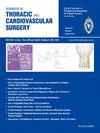高风险I期非小细胞肺癌患者的治疗选择:肺叶下切除术、立体定向消融放疗还是图像引导热消融?
IF 2.5
3区 医学
Q2 CARDIAC & CARDIOVASCULAR SYSTEMS
Seminars in Thoracic and Cardiovascular Surgery
Pub Date : 2025-03-01
DOI:10.1053/j.semtcvs.2024.10.004
引用次数: 0
摘要
目的:相当大比例的I期非小细胞肺癌(NSCLC)患者被认为是肺叶切除术后并发症或死亡的高风险患者。美国胸外科协会(AATS)此前发表了一份专家共识文件,详细说明了确定高危人群的重要考虑因素。目前的目的是评估这些高危患者的治疗方案和治疗选择时需要考虑的重要因素。方法:在系统回顾文献后,AATS专家组对高危I期NSCLC患者的治疗方案进行了评估。然后使用讨论和改进的德尔菲法制定了与治疗选择有关的专家共识声明和小片段。结果:专家小组确定了叶下切除术、立体定向消融放疗(SABR)和图像引导热消融(IGTA)是适用于高风险I期NSCLC患者的治疗方式。小组还确定了肺结节相关因素,这些因素在治疗选择中是重要的考虑因素。利用这些信息,专家组制定了14项共识声明和5个说明临床情景的小片段。结论:本文总结了在选择这些治疗方式时需要考虑的重要因素,这些方法适用于高危I期NSCLC患者。对于高风险的I期NSCLC患者,选择哪种方式(叶下切除术、SABR或IGTA)是最佳的是很复杂的,但在被认为安全的情况下,手术方式通常更受青睐。在特定患者中,SABR和IGTA是合理的选择。SABR比IGTA更常用,可能是次佳选择。对患者和肿瘤特征进行多学科回顾是实现最佳决策的必要条件。临床治疗决策还应考虑患者的观点、偏好和生活质量。本文章由计算机程序翻译,如有差异,请以英文原文为准。
Treatment Selection for the High-Risk Patient with Stage I Non-Small Cell Lung Cancer: Sublobar Resection, Stereotactic Ablative Radiotherapy or Image-Guided Thermal Ablation?
A significant proportion of patients with stage I non–small cell lung cancer (NSCLC) are considered at high risk for complications or mortality after lobectomy. The American Association for Thoracic Surgery (AATS) previously published an expert consensus document detailing important considerations in determining who is at high risk. The current objective was to evaluate treatment options and important factors to consider during treatment selection for these high-risk patients. After systematic review of the literature, treatment options for high-risk patients with stage I NSCLC were reviewed by an AATS expert panel. Expert consensus statements and vignettes pertaining to treatment selection were then developed using discussion and a modified Delphi method. The expert panel identified sublobar resection, stereotactic ablative radiotherapy (SABR), and image-guided thermal ablation (IGTA) as modalities applicable in the treatment of high-risk patients with stage I NSCLC. The panel also identified lung-nodule-related factors that are important to consider in treatment selection. Using this information, the panel formulated 14 consensus statements and 5 vignettes illustrating clinical scenarios. This article summarizes important factors to consider in treatment selection using these modalities, which are applicable in high-risk patients with stage I NSCLC. The choice of which modality (sublobar resection, SABR, or IGTA) is optimal in high-risk patients with stage I NSCLC is complex, but a surgical approach is generally favored when deemed safe. SABR and IGTA are reasonable options in select patients. SABR is more commonly used than IGTA and is likely the next-best choice. A multi-disciplinary review of patient and tumor characteristics is essential for achieving an optimal decision. The clinical treatment decision should also take patient perspectives, preferences, and quality of life into consideration.
求助全文
通过发布文献求助,成功后即可免费获取论文全文。
去求助
来源期刊

Seminars in Thoracic and Cardiovascular Surgery
Medicine-Pulmonary and Respiratory Medicine
CiteScore
5.80
自引率
0.00%
发文量
324
审稿时长
12 days
期刊介绍:
Seminars in Thoracic and Cardiovascular Surgery is devoted to providing a forum for cardiothoracic surgeons to disseminate and discuss important new information and to gain insight into unresolved areas of question in the specialty. Each issue presents readers with a selection of original peer-reviewed articles accompanied by editorial commentary from specialists in the field. In addition, readers are offered valuable invited articles: State of Views editorials and Current Readings highlighting the latest contributions on central or controversial issues. Another prized feature is expert roundtable discussions in which experts debate critical questions for cardiothoracic treatment and care. Seminars is an invitation-only publication that receives original submissions transferred ONLY from its sister publication, The Journal of Thoracic and Cardiovascular Surgery. As we continue to expand the reach of the Journal, we will explore the possibility of accepting unsolicited manuscripts in the future.
 求助内容:
求助内容: 应助结果提醒方式:
应助结果提醒方式:


